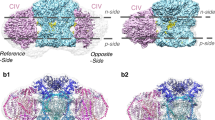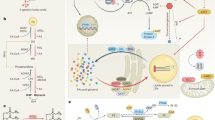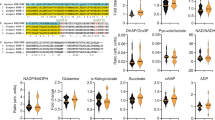Abstract
EVIDENCE was obtained previously1–3 that cardiolipin is composed of two phosphoric acid, three glycerol and four fatty acid residues. According to this structure the polyglycerophosphate skeleton (1) has five hydroxyl groups available for esterification. 
This is a preview of subscription content, access via your institution
Access options
Similar content being viewed by others
References
Macfarlane, M. G., and Gray, G. M., Biochem. J., 67, 25, P (1957).
Gray, G. M., and Macfarlane, M. G., Biochem. J., 70, 409 (1958).
Macfarlane, M. G., Nature, 182, 946 (1958).
Faure, M., and Morelec-Coulon, M. J., Ann. Inst. Pasteur, 91, 537 (1956).
Borgström, B., Acta Physiol. Scand., 30, 231 (1953).
Burmaster, C. F., J. Biol. Chem., 164, 233 (1946).
Pangborn, M. C., J. Biol. Chem., 168, 351 (1947).
Author information
Authors and Affiliations
Rights and permissions
About this article
Cite this article
MACFARLANE, M., WHEELDON, L. Position of the Fatty Acids in Cardiolipin. Nature 183, 1808 (1959). https://doi.org/10.1038/1831808a0
Issue date:
DOI: https://doi.org/10.1038/1831808a0
This article is cited by
-
Alkenyl and alkyl phosphatides in Proteus and its L forms
Archiv f�r Mikrobiologie (1972)
-
The composition of beef heart cardiolipins isolated by solvent and chromatographic fractionation
Lipids (1971)
-
Some structural investigations on phospholipids from membranes
Journal of the American Oil Chemists' Society (1966)
-
Chemical Structure and Serological Activity of Synthetic and Natural Cardiolipin
Nature (1965)
-
Characterization of Lipoamino-Acids as O-Amino-Acid Esters of Phosphatidyl-Glycerol
Nature (1962)



